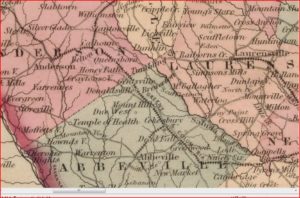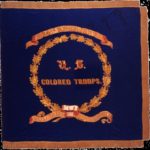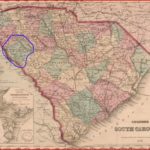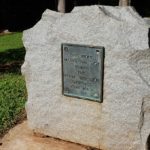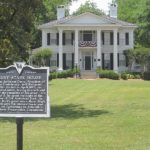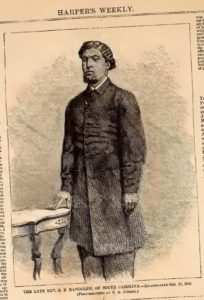
from chaplain to carpetbagger?
In mid-October 1868 The New-York Times reported that Benjamin F. Randolph, a black clergyman and Republican state legislator, was murdered in South Carolina.
In its November 21, 1868 issue, Harper’s Weekly reprinted the report of a Charleston newspaper:
MURDER OF THE REV. B. F. RANDOLPH.
One of the most satisfactory results of General GRANT’S accession to the Presidency will be peace in the South, involving protection to life as well as property, and a toleration of each political party of the opinions of the other. It is not chiefly the fact that GRANT has been elected President which will secure this result, but rather the utter defeat which that election brings upon them in the South who as a habit intimidate their political opponents and slay all whom they can not intimidate. It is now settled that the national law means Liberty and Equal Rights, and that those who violate that law must be punished as law-breakers. We give on this page a portrait of the Rev. B. F. RANDOLPH, a Methodist clergyman of South Carolina, and a Senator of that State, who, on the 17th of last month, fell a victim to assassination for his political opinions. Shortly after the murder the Charleston Christian Advocate published the following account:
“We are called upon to record one of the most daring and cold-blooded murders that ever darkened the pages of history, committed upon the person of one of the members of our Conference. The Rev. B.F. RANDOLPH was, on the 17th inst., assassinated, in open day, while traveling by public conveyance. He was upon a lecturing tour in one of the upper counties of the State. He lectured at Abbeville on the 15th inst., and left on Friday morning to do to Anderson, where he was to lecture in the evening. When he got upon the Greenville train at Hodge’s station he put his carpet-bag and shawl on a seat, and the returned to the platform of the car to speak to a colored man. While engaged in conversation with this person he was shot from behind by three ruffians, simultaneously, and fell dead, the shots taking effect in his head, lungs, and bowels. These murderers came to the depot on horseback, and immediately after committing the deed remounted their horses and rode quietly away. The report is that they are unknown and cannot be identified. This speaks for itself, when it is remembered that the deed was committed in open day, with the usual throng of passengers on the cars and around the depot. No one starts in pursuit, and all scorn to concede that it is useless to make any effort to identify or arrest the murderers. Brother RANDOLPH’S remains were taken on the following day to Columbia and interred on Sabbath, the 18th inst., with appropriate religious services, a vast concourse of people following them to the grave. Mr. RANDOLPH was born in Kentucky, and was educated at Oberlin, enjoying the advantages of the classical department. He was duly licensed and ordained as a minister in the Old School Presbyterian Church. Having received the appointment of chaplain in the army, and assigned to a colored regiment in that capacity, the fortunes of war brought him to our State. After the organization of the South Carolina Conference, he felt that the field opened by the Methodist Episcopal Church in this section would afford a greater opportunity for usefulness than he could enjoy in continuing his connection with the Presbyterian Church. He consequently solicited admittance to the Methodist Episcopal Church, and was duly received and admitted on trial at the session of our Conference in the spring of 1867. His first appointment was in connection with the Freedmen’s Bureau as Assistant Superintendent of Education in this State. His next appointment by the Conference was to Columbia. Although he was connected with our Conference, he received no fund from our Missionary Society. When the Charleston Advocate was started he held to it the relation of an assistant editor, in which he was continued until the resignation of the entire editorial corps in anticipation of the appointment of an editor, as arranged by the last General Conference. At the time of his death Mr. RANDOLPH was a member of the State Senate and Chairman of the Republican State Central Committee. In these official positions he was doing good service for his race and the cause of human rights. He took the position which he occupied in connection with the political interests of the State from a sense of duty which he could not well resist from the peculiar state of political affairs here.”
According to Wikipedia, Benjamin F. Randolph was born free in Kentucky and grew up in Ohio. He attended Oberlin College for about a year and then moved to Buffalo, New York in 1958. He worked as the principal of a public school for black children. In December 1863 Reverend Randolph volunteered for the Union army, serving as chaplain for the 26th Regiment Infantry U.S. Colored Troops. After the war he stayed in South Carolina. As a member of the Freedmen’s Bureau, Randolph worked as assistant superintendent for education in Charleston. He was a delegate to to the State Constitutional Convention of 1868 and later elected as state senator for the Orangeburg seat. Although a couple men were detained, no one was ever tried for the assassination.
You can read some more about B.F. Randolph at The History Engine.
The town where Reverend Randolph delivered his last speech has a couple blue-gray links. According to Wikipedia, Abbeville:
Abbeville has the unique distinction of being both the birthplace and the deathbed of the Confederacy. On November 22, 1860, a meeting was held at Abbeville, at a site since dubbed “Secession Hill”, to launch South Carolina’s secession from the Union; one month later, the state of South Carolina became the first state to secede.
At the end of the Civil War, with the Confederacy in shambles, Confederate President Jefferson Davis fled Richmond, Virginia, and headed south, stopping for a night in Abbeville at the home of his friend Armistead Burt. It was on May 2, 1865, in the front parlor of what is now known as the Burt-Stark Mansion that Jefferson Davis officially acknowledged the dissolution of the Confederate government, in the last official cabinet meeting.

